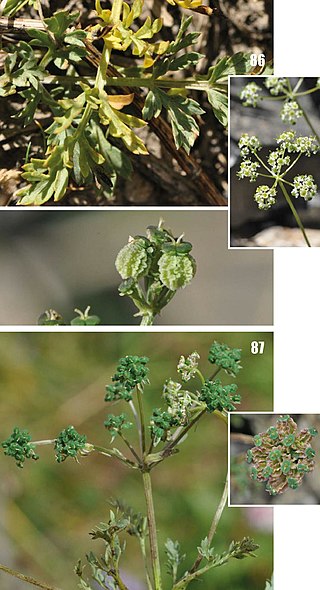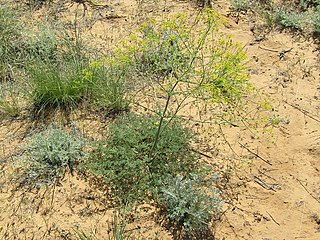
Aulacospermum is a genus of flowering plants in the family Apiaceae, with 15 accepted species. It is endemic to Central Asia and Eastern Europe.
Neoconopodium is a genus of flowering plant in the family Apiaceae, native to Pakistan and the western Himalayas. It may be subsumed into the genus Kozlovia.

Conioselinum is a genus of flowering plant in the family Apiaceae, native to Eurasia and North America. Its species are erect perennial plants with deeply toothed compound leaves and umbels of white flowers. Plants of this genus are known commonly as hemlock-parsley.

Seseli is a genus of herbaceous perennial plants in the family Apiaceae. They are sometimes woody at base with a conic taproot. Leaf blades are 1–3-pinnate or pinnately decompound. Umbels are compound, with bracts few or absent. Petals are white or yellow, and the fruit ovoid or ellipsoid.
Ladyginia is a genus of flowering plants belonging to the family Apiaceae.
Sofya Georgiyevna Tamamshyan (1901–1981) was a Russian-Soviet botanist and plant taxonomist noted for describing 7 genera and more than 50 species, and for authoring over 120 works. The standard author abbreviation Tamamsch. is used to indicate this person as the author when citing a botanical name.
Vicatia is a genus of flowering plants belonging to the family Apiaceae. It is also in tribe Selineae.
Tamamschjanella is a genus of flowering plants belonging to the family Apiaceae.
Ducrosia is a genus of flowering plants belonging to the family Apiaceae.
Kedarnatha is a genus of flowering plants belonging to the family Apiaceae.
Korshinskia is a genus of flowering plants belonging to the family Apiaceae. It is also in the Tribe Pleurospermeae.
Semenovia is a genus of flowering plants belonging to the family Apiaceae. It is in subfamily Apioideae and also tribe Tordylieae subtribe Tordyliinae.
Schulzia is a genus of flowering plants belonging to the family Apiaceae.

Elaeosticta is a genus of flowering plants belonging to the family Apiaceae.
Hymenidium is a genus of flowering plants belonging to the family Apiaceae.
Lalldhwojia is a genus of flowering plants belonging to the family Apiaceae. It is also within the tribe Tordylieae and subtribe Tordyliinae.

Neogaya is a monotypic genus of flowering plants belonging to the family Apiaceae. It contains just one species, Neogaya simplex, and can be found in Europe, the Alps, the western and southern Carpathians, former Yugoslavia, Belarus. European Russia, Kazakhstan, China, and western Siberia.
Pterocyclus is a genus of flowering plant in the family Apiaceae, native from the Himalayas to south-central China and northern Myanmar. The genus was first described by Johann Friedrich Klotzsch in 1862.
Hansenia is a genus of flowering plant in the family Apiaceae, native to from Siberia to China. The genus was first described by Nikolai Turczaninow in 1844.




